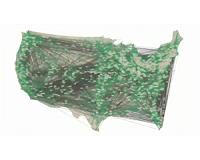 |
Redondo Beach CA (SPX) Nov 23, 2010 NASA's first hyperspectral imager in space, built by Northrop Grumman for the Goddard Space Flight Center, is observing its tenth anniversary on-orbit, outliving its design life by 1000 percent. Originally designed for one year of operation with a two year goal, Hyperion continues to deliver highly detailed observations of the Earth's surface, atmosphere and biomass. Built in just 12 months and launched onboard NASA's Earth Observing-1 (EO-1) satellite on Nov. 21, 2000, Hyperion has produced more than 50,000 images in the last decade. Optimizing the sensor's performance is a Northrop Grumman-built long-life pulse-tube cryocooler which has also operated flawlessly for 10 years. "Hyperion's longevity and robustness show that even our low-cost, rapidly deployed sensors far outlive their lifetime requirements," said Robert Burke, vice president of Civil and Military Systems for Northrop Grumman Aerospace Systems. "Delivering the highest value and reliability to our customers is a hallmark of our work." "Hyperion continues to give us images of unprecedented accuracy that enable us to determine land cover diversity and chemistry and assists in disaster relief, monitoring wildfire temperatures and the rate and temperature of lava flow," said Dr. Stephen Ungar, NASA EO-1 scientist emeritus and former EO-1 mission scientist. "Hyperion does a significantly better job of monitoring states of vegetative stress and deforestation than multispectral sensors." Hyperion was the first hyperspectral imager to demonstrate the value of space-based hyperspectral data used by the nation's science teams and commercial and military users. Hyperion's data products have proven their utility for worldwide land-cover studies, ecosystem monitoring, mineral and petroleum prospecting and agricultural crop discrimination and assessment, among other important applications. The company is continuing to develop sensor capabilities and associated enabling technologies. "An affordable follow-on to Hyperion is our Hyperspectral Airborne Terrestrial Instrument (HATI-2500), a new generation of hyperspectral sensor which provides more than three times the spectral resolution of Hyperion," said Mark Folkman, director of products and sensing for Northrop Grumman Aerospace Systems. "In addition to expanding on our industry-leading cryocooler technology, we have extended our hyperspectral imaging work from the visible and shortwave infrared wavelengths to the midwave and longwave infrared with our LongWave Hyperspectral Imaging Sensor (LWHIS). These additional wavelength ranges are important for monitoring atmospheric chemistry and pollutants/effluents." One of three science instruments aboard EO-1, Hyperion is designed to view the Earth in 220 spectral bands ranging from the visible through short wave infrared. Hyperion was the first space sensor to show that vegetation biomass, atmospheric carbon content, and carbon uptake of the oceans - important elements of climate change measurement - can be monitored using hyperspectral data. Completing its mission as part of NASA's New Millennium Program after one year, Hyperion has been in an extended mission since. The New Millennium Program demonstrated advanced technologies and designs that show promise for dramatically reducing the cost and improving the quality of instruments and spacecraft for future missions.
Share This Article With Planet Earth
Related Links NASA's Earth Observing-1 (EO-1) satellite Earth Observation News - Suppiliers, Technology and Application
 Redrawing Our Borders
Redrawing Our BordersEvanston IL (SPX) Nov 22, 2010 What are borders these days? When travel was local, borders and communities were easy to define, but now our connectivity is more complex. It's time to think of borders differently, according to Northwestern University researchers. To reflect today's reality, they have taken a look at human mobility and redrawn the borders within the United States, showing areas of the country that are mos ... read more |
|
| The content herein, unless otherwise known to be public domain, are Copyright 1995-2010 - SpaceDaily. AFP and UPI Wire Stories are copyright Agence France-Presse and United Press International. ESA Portal Reports are copyright European Space Agency. All NASA sourced material is public domain. Additional copyrights may apply in whole or part to other bona fide parties. Advertising does not imply endorsement,agreement or approval of any opinions, statements or information provided by SpaceDaily on any Web page published or hosted by SpaceDaily. Privacy Statement |